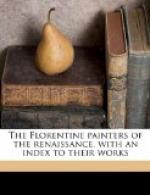It is just here that the scientific spirit of the Florentine naturalists was of immense service to art. This logic of sequence is to be attained only by great, although not necessarily more than empiric, knowledge of anatomy, such perhaps as the artist pure would never be inclined to work out for himself, but just such as would be of absorbing interest to those scientists by temperament and artists by profession whom we have in Pollaiuolo and, to a less extent, in Verrocchio. We remember how Giotto contrived to render tactile values. Of all the possible outlines, of all the possible variations of light and shade that a figure may have, he selected those that we must isolate for special attention when we are actually realising it. If instead of figure, we say figure in movement, the same statement applies to the way Pollaiuolo rendered movement—with this difference, however, that he had to render what in actuality we never can perfectly isolate, the line and light and shade most significant of any given action. This the artist must construct himself out of his dramatic feeling for pressure and strain and his ability to articulate the figure in all its logical sequences, for, if he would convey a sense of movement, he must give the line and the light and shade which will best render not tactile values alone, but the sequences of articulations.
[Page heading: “BATTLE OF THE NUDES”]




